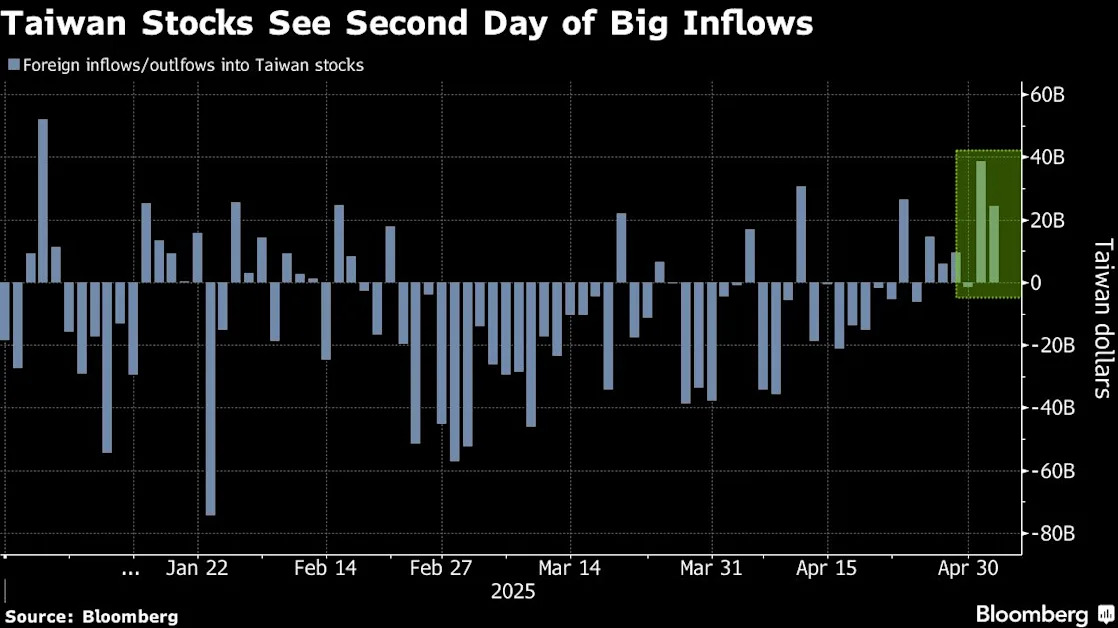(Bloomberg) -- A recent surge in Asian currencies is shifting the outlook for the region’s equities, with money managers and strategists favoring stocks tied to local consumption and expecting a return of global funds.
Morgan Stanley strategists said they like markets including India and the Philippines, where stocks tend to be more geared toward domestic demand. They favor sectors such as real estate and financials. Aberdeen Investments prefers defensive plays like consumer and healthcare stocks, while Societe Generale SA sees India as a major beneficiary from its trade negotiations with the US.
A stronger currency tends to put exporters at a disadvantage, but the appreciation trend in Asia can be an overall positive for stocks if foreign investors are lured by the exchange-rate outlook. Central banks also have more leeway to cut interest rates to support the economy. Stocks in Taiwan have seen global funds return after months of outflows as the local currency advanced nearly 10% over the past month. For India too, currency gains have coincided with foreign inflows into stocks.
“When Asian currencies appreciate, it almost always leads to foreign fund inflows into Asian equities,” said Manishi Raychaudhuri, chief executive officer at Emmer Capital. “The markets that would receive the highest flows are likely the markets that were sold down the most, including India, Korea and Taiwan.”
Raychaudhuri added he likes domestically oriented stocks such as Chinese internet platforms, Korean and Chinese financials, Indian banks and consumer discretionaries.
The Malaysian ringgit and South Korean won have also strengthened more than 4% against the greenback over the past month.
The advance in Asia’s currencies reinforces the “sell America” theme and provides a major tailwind for regional equities to continue to outperform the US. The MSCI Asia Pacific Index has gained 4.8% this year, compared with a near 4% drop in the S&P 500 Index.
“In Asia we have started to observe some returns of foreign flows into India equities,” said Frank Benzimra, head of Asia equity strategy at Societe Generale. “If the market starts to price that the dollar could also decline versus the whole emerging market FX, that would be an additional bull element for emerging equities.”
Investors are also scrutinizing countries’ progress in tariff negotiations to pick stock winners. India has proposed zero tariffs on steel, auto components and pharmaceuticals on a reciprocal basis up to a certain quantity of imports in its trade negotiations with the US, people familiar with the matter said.
“We think India is perhaps best positioned in Asia around US tariffs, and we also like the Philippines and Singapore where tariffs are the lowest in Southeast Asia,” said Xin-Yao Ng, a fund manager at Aberdeen Investments.
To be sure, uncertainties over the global trade war and the potential damage to exporters’ earnings from stronger local currencies may offset some of the optimism. Analysts said the earnings of tech companies in Taiwan are likely to be impacted, given that the bulk of their revenue is in dollar terms.
“We find the valuations of Taiwan and South Korea more interesting, but we feel that the recent currency appreciation and possible additional Trump announcement on section 232 tariffs on semiconductors are hurdles for more aggressive bullish view,” said Homin Lee, senior macro strategist at Lombard Odier.
Still, if some of the billions of dollars of funds that have left Asia this year make their way back, that itself would provide a major boost.
“A lower dollar is an important driver of relative EM returns in favor of markets and companies with local currency revenues,” Morgan Stanley strategists including Daniel Blake wrote this week. “We reiterate our preferences for domestic demand in Asia/EM.”


